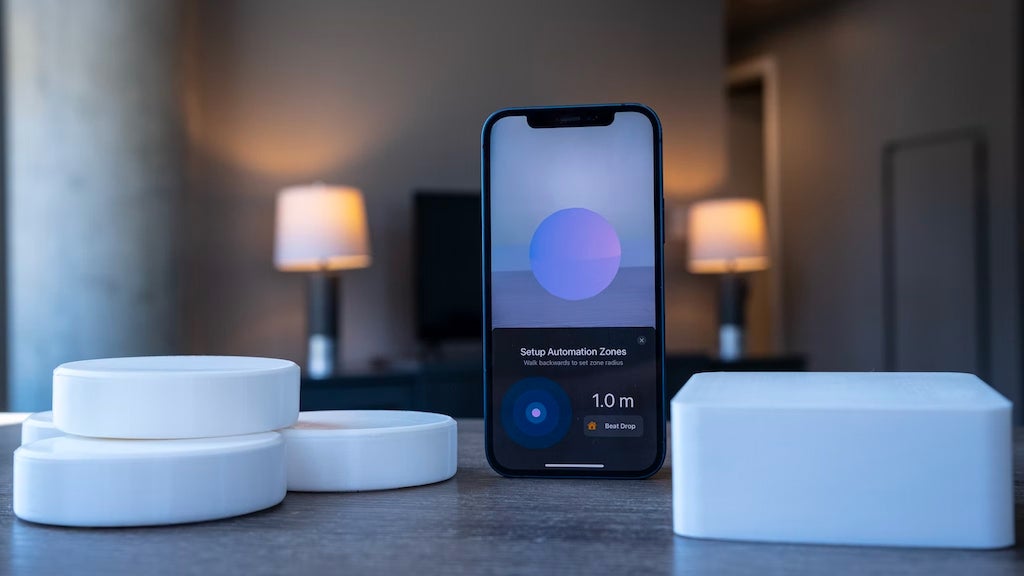Last December, we got a sneak peek at a radical new way to interact with the myriad of smart devices in our homes. It was a point and click iPhone app that eliminated the need for voice commands or jumping between device specific apps. But it turns out developer Bastian Andelefski’s neat iOS demo wasn’t just a concept; he’s actually the Technical Advisor for a new smarthome remote called Fluid One that’s now raising funds through a Kickstarter campaign.
Competition in the marketplace is usually never a bad thing, but it can also sometimes unnecessarily complicate devices for consumers, particularly when companies strive to make their specific technology the de facto standard. For example, HDMI is an easy way to connect a number of devices and displays, but what if Sony, Samsung, and LG all introduced their own competing cable standards? That’s the issue that’s plaguing the smarthome now. There are multiple product eco-systems all in competition with each other, and it not only hurts the consumer: it’s holding the smarthome industry back.
There is reason to be cautiously optimistic about the smarthome getting better, including the Matter initiative, which has brought countless companies together in an attempt to make smarthome devices play nice with each other. But a lack of interoperability is only part of the problem. Matter makes no promises of improving how users interact with their smart devices, which Fluid One’s co-founder, Tim Ho, believes is an even bigger problem.
“Smart home interactions are unintuitive and inefficient, whether it be navigating through several dedicated applications, constructing tedious voice commands or setting up countless individual sensors for automation,” Ho told Gizmodo via email. Ho also speculated that Matter will improve some parts of the smarthome, but has the potential to actually further complicate what’s already a messy situation. “With the rising adoption of the Matter initiative, we envision that people will start integrating more disjoint devices and new capabilities into their smart homes. The interaction problems we see today will become even more pronounced then.”
When Andelefski released his demo video last December, he hoped he could find a hardware developer to partner with to take the ideas from the concept stage to a consumer-ready device, and that’s what Fluid One is hoping to deliver. The system leverages the ultra-wideband U1 chip that Apple has been including in its smartphones since the iPhone 11, as well as Apple’s augmented reality developer tools, plus additional UWB beacons and an optional smart hub that can be purchased through this Kickstarter campaign.

Fluid One uses the UWB signals from the beacons alongside Apple’s ARKit to map out the various rooms in a user’s home and figure out not only where an iPhone is located in that space, but where all the smart devices are, and which one the iPhone is being pointed toward. This allows an app to selectively display contextual controls for a specific smart device when a user points their iPhone at it like a TV remote. Lamps may bring up a colour wheel, while a smart speaker may bring up a volume control. The idea is that, instead of making users navigate through countless menus or multiple apps to find the controls they want, the system makes a very educated guess about what they want to control. That includes automations as well, which can be limited to where a person actually is, such as nearby lights automatically turning on in the evening.
As cool as it all sounds, the UWB chips that the Fluid One system relies on for its beacons (which have a limited range of around 6.10 m, so several need to be placed around a room that has multiple smarthome devices in it) sound like bleeding edge technology. The Kickstarter crowdfunding campaign is hoping to raise $US100,000 ($138,820) to help put the hardware into production, with the cheapest option, for just four beacons, starting at $US249 ($346), or $US449 ($623) if you also want the hub that enables automation. Full retail pricing is expected to be closer to $US400 ($555) and $US600 ($833), respectively.
Delivery isn’t expected until late next year, so as with most Kickstarter products, a heaping helping of patience is recommended here. Fluid One will also be limited to users with an iPhone 11 or newer for a while, or at least until Google implements some necessary tools to make the system work with Android phones. It all sounds very cool and obviously demos quite well, but so did all of the smarthome gadgets we now find frustrating to use. We hope Fluid One will be a remedy, and not just another layer of complication the smarthome doesn’t need.
